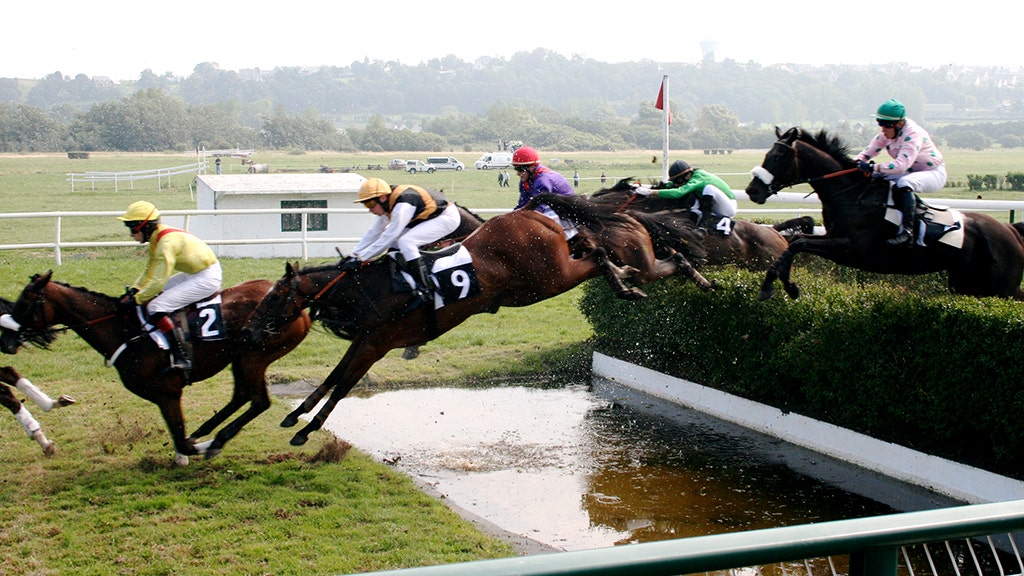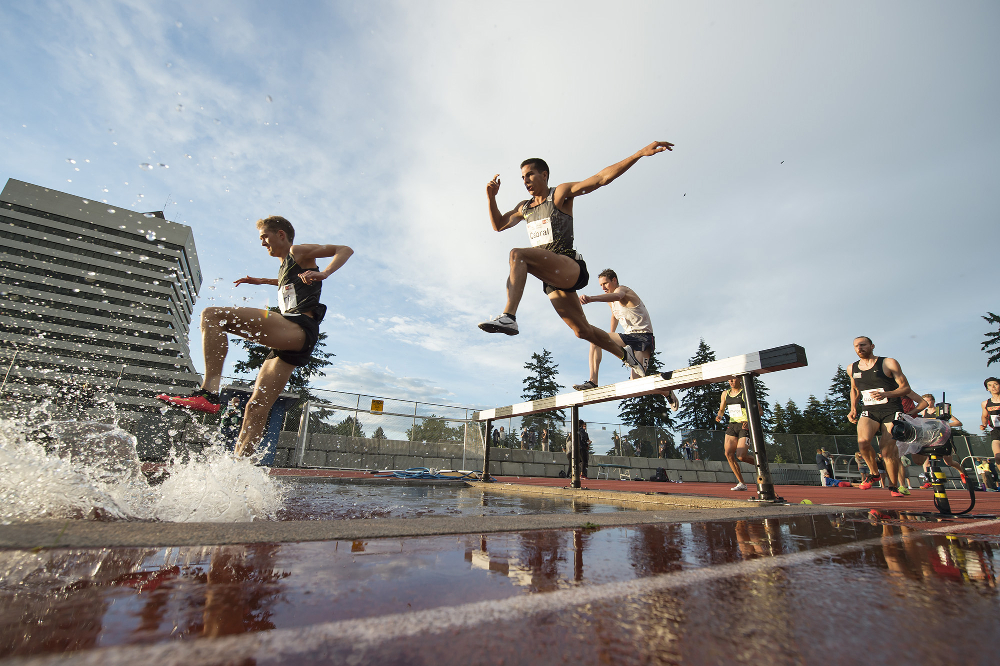The Mechanics of a Steeplechase Fall

Steeplechase, a thrilling track and field event, is known for its challenging obstacles, especially the water jump. This unique element adds an extra layer of complexity to the race, and falls are an unfortunate but common occurrence. Understanding the mechanics behind these falls is crucial for both athletes and spectators alike.
Common Causes of Falls
Falls in steeplechase races can occur due to a variety of factors. These include:
- Loss of Balance: The high-speed nature of the race, combined with the need to navigate obstacles, can lead to a loss of balance. This can happen when athletes attempt to clear the hurdles too high, land awkwardly, or misjudge the distance to the water jump.
- Foot Placement: Improper foot placement, particularly on the hurdles, can result in falls. Landing with the foot too far forward or too far back can disrupt the athlete’s balance, leading to a stumble or fall.
- Fatigue: As the race progresses, fatigue can set in, impacting an athlete’s coordination and reaction time. This can increase the likelihood of falls, especially as the obstacles become more challenging.
- Contact with Other Athletes: Collisions with other athletes are a common cause of falls in any running race, and steeplechase is no exception. These collisions can occur during the water jump, over hurdles, or even during the race’s initial stages.
The Water Jump and Falls
The water jump, a distinctive feature of steeplechase, presents unique challenges that contribute to falls.
- Landing in the Water: The act of landing in the water itself can be unpredictable, as athletes must adjust their approach and landing based on the water’s depth and current.
- The Splash: The impact of landing in the water can create a splash that can disrupt an athlete’s balance, making it harder to regain their footing and continue running.
- Water Depth and Current: The depth and current of the water can vary, affecting an athlete’s ability to navigate the jump safely. Shallow water can make it difficult to maintain momentum, while strong currents can pull athletes off course.
Frequent Points of Contact for Falls
Falls in steeplechase are most common at specific points in the race:
- Hurdles: The hurdles, with their varying heights and placements, are a frequent source of falls. Athletes must clear the hurdles cleanly, avoiding contact with the barrier itself.
- Water Jump: The water jump is another high-risk area for falls, as the unpredictable nature of the water can lead to misjudged landings and loss of balance.
- Turns: Tight turns in the race can also contribute to falls, as athletes must maintain their speed and balance while navigating the curve.
Types of Falls and Consequences
Falls in steeplechase can vary in severity, with potential consequences ranging from minor injuries to serious setbacks.
- Minor Falls: These often involve a stumble or a slight loss of balance, resulting in a minor setback but allowing the athlete to quickly recover and continue racing.
- Major Falls: These falls can involve significant impact, leading to injuries such as sprains, strains, or even fractures. These injuries can force athletes to withdraw from the race and require medical attention.
- Falls During the Water Jump: Falls during the water jump can be particularly dangerous, as the impact with the water can cause injuries to the head, neck, or spine.
Impact of Falls on Performance and Safety: Men’s Steeplechase Fall

A fall in a steeplechase race can have a significant impact on a runner’s performance and safety, potentially leading to injuries, setbacks, and even career-ending consequences. This section delves into the various aspects of falls in steeplechase races, examining their impact on athletes’ physical and mental well-being, the risks associated with them, and the potential for injury.
Impact on Physical and Mental State
Falls in steeplechase races can significantly impact a runner’s physical and mental state. The immediate consequences include pain, shock, and disorientation. More serious injuries such as fractures, dislocations, and ligament tears are also possible. The severity of these injuries can vary depending on the force of the impact, the landing position, and the nature of the terrain.
The mental impact of a fall can be equally significant. Runners who have experienced a fall may develop fear of the water jump or other obstacles, leading to hesitation and decreased confidence. This fear can negatively impact their performance, making them more prone to further falls. In some cases, athletes may even experience post-traumatic stress disorder (PTSD) after a severe fall.
Impact on Race Outcomes and Careers
Falls have a direct impact on race outcomes, often leading to a runner’s elimination from the competition. Even if a runner manages to get back up and continue the race, they may lose valuable time and momentum, impacting their final position.
In some instances, falls have had a significant impact on athletes’ careers. For example, a serious injury sustained in a fall could lead to a lengthy recovery period, putting a runner’s career on hold. Some athletes may never fully recover from a severe injury, ultimately forcing them to retire prematurely.
Risks and Dangers Associated with Falls
Falls in steeplechase races carry a significant risk of injury, ranging from minor sprains and bruises to serious fractures and dislocations. The potential for injury is amplified by the presence of obstacles, particularly the water jump. The water jump requires runners to jump over a barrier and land in a pool of water, increasing the risk of slips and falls.
The risk of injury is further exacerbated by the high speeds at which steeplechase runners compete. A fall at high speed can result in severe injuries, including head trauma, spinal cord injuries, and internal bleeding. The impact of a fall can also be compounded by the uneven terrain and the presence of other runners.
Safety Protocol for Steeplechase Races, Men’s steeplechase fall
To minimize the risk of falls and enhance the safety of steeplechase runners, a comprehensive safety protocol should be implemented. This protocol should address various aspects of the race, including course design, obstacle construction, and athlete preparation.
Course Design
– The course should be designed to minimize the risk of falls, with a focus on smooth transitions and clear obstacle markings.
– The water jump should be designed with a safe entry and exit point, with sufficient water depth to prevent injury.
– The course should be inspected regularly for any potential hazards, such as loose gravel or uneven surfaces.
Obstacle Construction
– Obstacles should be constructed with safety in mind, using durable materials and secure attachments.
– The water jump should be equipped with safety netting to prevent runners from falling into the water.
– The height and width of the obstacles should be standardized to ensure consistency and minimize the risk of falls.
Athlete Preparation
– Athletes should be adequately trained in the proper technique for negotiating obstacles, including the water jump.
– Athletes should be educated on the risks associated with falls and the importance of safety precautions.
– Athletes should be encouraged to wear appropriate footwear and clothing that provides adequate protection.
Notable Steeplechase Falls in History

Steeplechase falls are an unfortunate but inevitable part of the sport. Over the years, there have been numerous instances of athletes taking a tumble over the barriers, sometimes with serious consequences. These falls not only affect the race outcome but can also have a lasting impact on the athletes’ careers. This section will delve into some of the most notable steeplechase falls in history, examining their causes, outcomes, and the lessons learned from them.
Notable Steeplechase Falls and Their Impact
| Athlete | Race | Cause of Fall | Impact |
|---|---|---|---|
| Kenyatta Kiplagat | 2013 World Championships, Moscow | Lost his balance while clearing a barrier | Kiplagat was in contention for a medal when he fell, ultimately finishing 10th. The fall marked a setback in his career, though he later rebounded to win the 2014 Commonwealth Games. |
| Evan Jager | 2016 Rio Olympics | Tripped over a barrier | Jager, the American record holder, was leading the race when he fell, ultimately finishing 7th. This fall was a significant disappointment for Jager, who was aiming for a medal. |
| Conseslus Kipruto | 2017 World Championships, London | Lost his balance while clearing a barrier | Kipruto, the reigning Olympic champion, was in the lead when he fell, ultimately finishing 11th. This fall was a shock to the athletics world, as Kipruto was considered one of the best steeplechasers of his generation. |
Men’s steeplechase fall – These falls highlight the inherent risks of steeplechase racing. The high barriers and water jump pose significant challenges for athletes, and even the slightest misstep can lead to a fall. While some falls result in minor injuries and setbacks, others can have more serious consequences, impacting an athlete’s career trajectory.
Types of Falls and Their Outcomes
Steeplechase falls can be categorized based on their cause, which often determines their severity and impact on the athlete. Here are some common types of falls and their potential outcomes:
- Barrier Falls: These are the most common type of fall, often occurring when athletes misjudge their approach to the barrier or lose their balance while clearing it. These falls can range from minor stumbles to significant impacts, depending on the height of the barrier and the athlete’s speed.
- Water Jump Falls: These falls occur when athletes misjudge the water jump, either landing too short or too long. These falls can be particularly dangerous, as athletes can suffer injuries from the impact with the water or the bank of the jump.
- Foot Injuries: Falls can also result from foot injuries, such as sprains or fractures. These injuries can occur when athletes land awkwardly after a fall or when they are forced to change direction quickly to avoid a collision.
Lessons Learned from Steeplechase Falls
Notable steeplechase falls have taught valuable lessons about the sport and the importance of safety. Here are some key takeaways:
- Barrier Technique: Athletes must develop a strong barrier technique to minimize the risk of falls. This includes proper approach, takeoff, and landing techniques.
- Water Jump Strategy: Athletes need to develop a strategic approach to the water jump, considering their speed, momentum, and the conditions of the jump.
- Safety Measures: Race organizers must prioritize safety by implementing appropriate measures, such as barrier padding and trained medical personnel on standby.
- Recovery and Rehabilitation: Athletes who suffer falls need to focus on proper recovery and rehabilitation to minimize the long-term impact on their careers.
The men’s steeplechase is a thrilling event, but it’s not without its risks. One moment you’re soaring over a hurdle, the next you’re sprawled on the track. It’s a reminder that even the most skilled athletes are vulnerable. The resilience of these athletes is comparable to the enduring legacy of the quincy hall gold grill , a symbol of history and culture that has stood the test of time.
Just as the steeplechase runners rise again after a fall, the grill remains a testament to the enduring spirit of its community. The race may be over for some, but the drive to overcome obstacles and push boundaries remains strong, just like the spirit of the grill itself.
The men’s steeplechase fall was a heart-stopping moment, a reminder of the unpredictable nature of athletics. It’s a stark contrast to the pure speed and focus of the 400 m final men , where every stride is a calculated burst of energy.
While the steeplechase fall serves as a cautionary tale, the 400 m final highlights the sheer athleticism and determination required to succeed at the highest level.